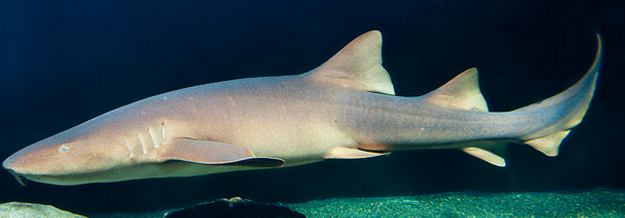
Nurse shark
The nurse shark is an elasmobranch fish within the family Ginglymostomatidae. They are directly targeted in some fisheries and considered as bycatch in others.
The nurse shark (Ginglymostoma cirratum) is an elasmobranch fish within the family Ginglymostomatidae. They are directly targeted in some fisheries and considered as bycatch in others. Nurse shark conservation status is globally assessed as being Data Deficient due to the lack of information across its range in the Eastern Pacific and Eastern Atlantic. They are considered to be Near Threatened in the Western Atlantic due to their vulnerable status in South America and reported threats throughout many areas of Central America and the Caribbean; and they are considered to be a species of Least Concern in the U.S. and Bahamas
The Nurse Shark, also known as the Ginglymostoma cirratum, gets its name from Greek Roots. It may come from the strange sucking sounds they make when searching for prey in the sand. As with all sharks, this giant fish is incredibly interesting and very important to the delicate marine ecosystem, especially near fragile coral reefs.
They can get quite large with a length of up to 4.5 meters (15ft) as adults. These large creatures reach weights as high as 150 kilograms (330 pounds). Typically, they live to between 25 and 35 years of age.
While most fish, including sharks, must keep moving in order to breath, Nurse Sharks can remain motionless while resting on the sea floor by facing against the flow of water and pumping the water through their mouths and gills.
As a bottom dweller, they spend much of their time on the sea floor in tropical waters around coastal shelves, reefs, and channels. They seem to enjoy the Atlantic and Pacific Oceans, especially around the Caribbean Islands. This is generally a shallow water fish.
During daylight hours, they are seen in groups as large as 40. While in these groups, they mostly remain hidden under submerged ledges and around reefs. Scientists believe they stay in these groups for protection purposes only with very little dominance or hierarchy.At night, they become more active, but also more solitary, wandering the waters alone.
Being bottom dwellers with small mouths, they are unable to consume large fish. They hunt alone and catch their prey from the sea floor, mostly by sucking their prey into their mouths. While doing this, a Nurse Shark will inevitably make an unmistakable “slurping” or sucking sound, completely unique to this species.
The preferred prey includes sea snails, crustaceans, mollusks, and other small fish. In addition, they have been seen grazing for algae and ground corals.
This shark species is Viviparous, meaning eggs develop within the uterus of a female until birth. The pregnancy period usually lasts about 6 months with births occurring generally in the months of June and July. After birth, an adult female Nurse Shark is unable to produce eggs for 18 months.
In average, 30 pups are born at a time. Cannibalism between pups does occur, with the larger and stronger pups eating the underdeveloped ones.
When pups are born they are only about 30cm long (12in) and have a spotted colored skin. As with Tiger Sharks, they lose the spotted patterns with age.
Great barracuda
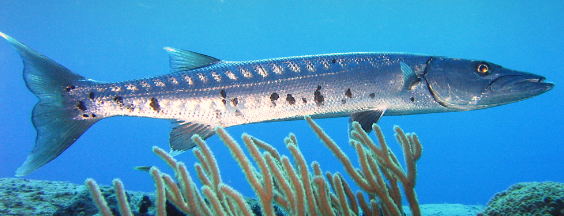
The great barracuda also known as the giant barracuda, is a common species of barracuda found in subtropical oceans around the world. It is a type of ray-finned fish.
Barracuda are snake-like in appearance, with prominent, sharp-edged, fang-like teeth, much like piranha, all of different sizes, set in sockets of their large jaws. They have large, pointed heads with an underbite in many species. Their gill covers have no spines and are covered with small scales. Their two dorsal fins are widely separated, with the anterior fin having five spines, and the posterior fin having one spine and 9 soft rays. The posterior dorsal fin is similar in size to the anal fin and is situated above it. The lateral line is prominent and extends straight from head to tail. The spinous dorsal fin is placed above the pelvic fins and is normally retracted in a groove. The caudal fin is moderately forked with its posterior edged double-curved and is set at the end of a stout peduncle. The pectoral fins are placed low on the sides. Its swim bladder is large.
In most cases, a barracuda is dark gray, dark green, white, or blue on its upper body, with silvery sides and a chalky-white belly. Coloration varies somewhat between species. For some species, irregular and unorganized black spots or a row of darker cross-bars occur on each side. Their fins may be yellowish or dusky. Barracudas live primarily in oceans, but certain species, such as the great barracuda, live in brackish water.
Some species grow quite large (up to 165 cm in length), such as Sphyraena sphyraena, found in the Mediterranean Sea and eastern Atlantic; Sphyraena picudilla, ranging on the Atlantic coast of tropical America from North Carolina to Brazil and reaching Bermuda. Other barracuda species are found around the world. Examples are Sphyraena argentea, found from Puget Sound southwards to Cabo San Lucas, Sphyraena jello, from the seas of India and the Malay Peninsula and Archipelago.
Rainbow parrotfish
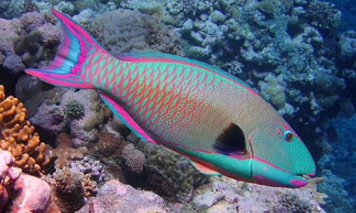
The rainbow parrotfish is a species of fish in the Scaridae family.The species is among the largest members of its family, and the largest in the Atlantic, reaching 1.2 m (3.9 ft) in length, 20 kg in weight and a maximum age of 16 years. It has a greenish-brown overall colouration; the fins are dull orange with tongues of green. Its dental plates are blue-green. Sexes appear alike
The rainbow parrotfish has a relatively wide distribution in the western Atlantic, and can be found from Bermuda through south Florida, the Bahamas and the Caribbean to Venezuela. It inhabits coral reefs, mangroves and sea grass beds in shallow waters, at depths of 3–25 m.The rainbow parrotfish has a relatively wide distribution in the western Atlantic, and can be found from Bermuda through south Florida, the Bahamas and the Caribbean to Venezuela. It inhabits coral reefs, mangroves and sea grass beds in shallow waters, at depths of 3–25 m.
The species was formerly classified as vulnerable due to overfishing and habitat loss, but because the presently available data do not allow an estimate of the population decline, it is now considered near threatened by the IUCN. It is relatively rare in most of its range, but more common in Bermuda. The rainbow parrotfish is widely harvested in subsistence fisheries in many parts of the Caribbean.
Queen angelfish
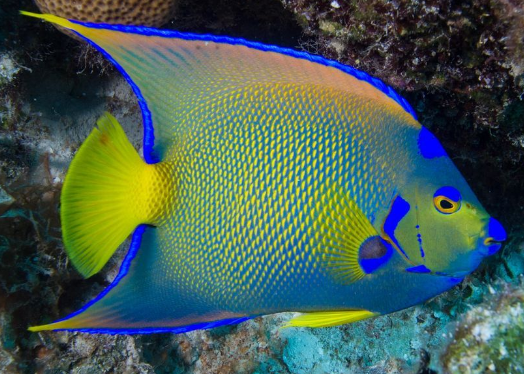
The queen angelfish is a marine angelfish commonly found near reefs in the warmer sections of the western Atlantic Ocean. Other common names include blue angelfish, golden angelfish, queen angel, and yellow angelfish.
The queen angelfish (Holacanthus ciliaris) is a marine angelfish commonly found near reefs in the warmer sections of the western Atlantic Ocean. Other common names include blue angelfish, golden angelfish, queen angel, and yellow angelfish. Holocanthus ciliaris should not be confused with Holocanthus bermudensis, or the (Bermuda) blue angelfish, despite very similar appearances. They are two separate species.
The adult queen angelfish overall body color can be described as blue to blue-green with yellow rims on its scales. Their pectoral and ventral fins are also yellow but their lips and the edges of their dorsal fins and anal fins are dark blue. Queen angelfish are also known to have blue markings around each gill cover. Juveniles have dark blue bodies with yellow lips, gills, and tail and vertical bars ranging in color from light blue to white. The colors of the juvenile fish help them to blend in with the reefs. The queen angelfish may live up to 15 years in the wild and reach up to 45 centimeters (17 inches) in length. Queen angelfish are about three and a half pounds.
The queen angelfish feeds primarily on sponges, but also feeds on tunicates, jellyfish, and corals as well as plankton and algae. Juveniles serve as “cleaners” and feed on the parasites of larger fish at cleaning stations. Although in home aquariums, aquarists have been successful in providing the queen angelfish a diet of meaty and algae based foods.
Queen angelfish inhabit reefs and are common near Florida, especially the Florida Keys, and also the Bahamas and the Gulf of Mexico. It is rarely seen in the Bermuda Triangle and ranges as far south as Brazil and as North as Long Island.
The adults are found in pairs year round, perhaps suggesting a long-term monogamous bond. The pairs reproduce by rising up in the water, bringing their bellies close together, and release clouds of sperm and eggs. The female can release anywhere from 25 to 75 thousand eggs each evening and as many as ten million eggs during each spawning cycle. The eggs are transparent, buoyant, and pelagic, floating in the water column. They hatch after 15 to 20 hours into larvae that lack effective eyes, fins, or even a gut. The large yolk sac is absorbed after 48 hours, during which time the larvae develop normal characteristics of free swimming fish. Larvae are found in the water column and feed on plankton. The larvae grow rapidly and about 3–4 weeks after hatching the 15–20 millimetres (0.6–0.8 in) long juvenile settles on the bottom.
Western Mosquitofish
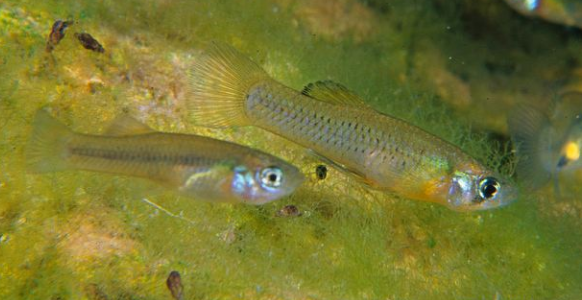
The western mosquitofish (Gambusia affinis) is a species of freshwater fish, also known commonly, if ambiguously, as simply mosquitofish or by its generic name, Gambusia, or by the common name gambezi. There is also an eastern mosquitofish (G. holbrooki).
Mosquitofish are small in comparison to many other freshwater fish, with females reaching an overall length of 7 cm (2.8 in) and males at a length of 4 cm (1.6 in). The female can be distinguished from the male by her larger size and a gravid spot at the posterior of her abdomen. The name “mosquitofish” was given because the diet of this fish sometimes consists of large numbers of mosquito larvae, relative to body size. Gambusia typically eat zooplankton, beetles, mayflies, caddisflies, mites, and other invertebrates; mosquito larvae make up only a small portion of their diet.[4]
Mosquitofish were introduced directly into ecosystems in many parts of the world as a biocontrol to lower mosquito populations which in turn negatively affected many other species in each distinct bioregion. Mosquitofish in Australia are classified as a noxious pest and may have exacerbated the mosquito problem in many areas by outcompeting native invertebrate predators of mosquito larvae. Several counties in California distribute mosquitofish at no charge to residents with manmade fish ponds and pools as part of their mosquito abatement programs. The fish are made available to residents only and are intended to be used solely on their own property, not introduced into natural habitat. On 24 February 2014, Chennai Corporation in India introduced western mosquitofish in 660 ponds to control the mosquito population in freshwater bodies.
Fertilization is internal; the male secretes milt into the genital aperture of the female through his gonopodium. Within 16 to 28 days after mating, the female gives birth to about 60 young. The males reach sexual maturity within 43 to 62 days. The females, if born early in the reproductive season, reach sexual maturity within 21 to 28 days; females born later in the season reach sexual maturity in six to seven months.
Red Lion Fish

The red lionfish (Pterois volitans) is a venomous coral reef fish in the family Scorpaenidae, order Scorpaeniformes. P. volitans is natively found in the Indo-Pacific region, but has become an invasive problem in the Caribbean Sea, as well as along the East Coast of the United States. This and a similar species, Pterois miles, have both been deemed as invasive species. Red lionfish are clad in white stripes alternated with red/maroon/brown stripes. Adults in this species can grow as large as 47 cm (18.5 in)[1] in length, making it one of the largest species of lionfish in the ocean, while juveniles are typically shorter than 1 inch (2.5 cm).[2] The average red lionfish lives around 10 years.[3] As with many species within the Scopaenidae family, it has large, venomous spines that protrude from the body, similar to a mane, giving it the common name lionfish. The venomous spines make the fish inedible or deter most potential predators. Lionfish reproduce monthly and are able to quickly disperse during their larval stage for expansion of their invasive region. No definitive predators of the lionfish are known, and many organizations are promoting the harvest and consumption of lionfish in efforts to prevent further increases in the already high population densities.